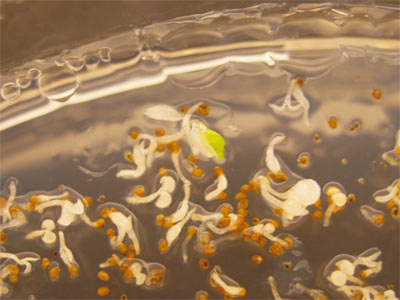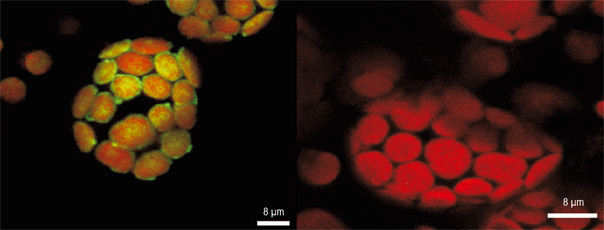Potsdam-Golm, Germany
April 12, 2007Weibliche
Eigenschaften bringen mehr gentechnische Sicherheit bei Pflanzen
Männer
sind anders, Frauen auch - ähnliches gilt auch für die
Pflanzenwelt. Auch hier spielen die Unterschiede zwischen den
Geschlechtern eine Rolle, speziell was die Weitergabe von
Erbanlagen betrifft. Anders als die Gene im Zellkern werden die
in Chloroplasten enthaltenen Gene bei den meisten Pflanzen nur
von der Mutter vererbt. Dies könnte die Sicherheit beim Einsatz
gentechnisch veränderter Pflanzen verbessern. Wissenschaftler
vom Max-Planck-Institut für Molekulare Pflanzenphysiologie haben
nun bestätigt, dass sich mit der Chloroplasten- transformation
veränderte Gene nur äußerst selten von Kulturpflanzen auf solche
in Nachbarkulturen oder auf Wildpflanzen überspringen:
Manipulieren sie nur die Erbinformation in den Chloroplasten
männlicher Gewächse, tragen nur sehr wenige Pollen die
genetische Änderung - so dass das Risiko, die Genvarianten in
der Nachbarschaft zu verteilen, auf ein Minimum sinkt.
(Proceedings of the National Academy of Sciences, 9. April 2007)
 |
|
Abb. 1 Der grüne
Keimling ist gegen ein sonst tödliches
Antibiotikum resistent. Erworben hat die Pflanze
die Resistenz über die Erbinformation in den
Chloroplasten ihrer Vaterpflanze - ein sehr
seltener Prozess.
Bild: Max-Planck-Institut für molekulare
Pflanzenphysiologie |
|
Das neue Verfahren beruht auf
der gentechnischen Veränderung der Chloroplasten, jener Teile
der Zelle, in denen die Photosythese abläuft und die eine
eigene, vom Zellkern unabhängige genetische Information
enthalten. Da diese und die in ihnen enthaltenen Gene nur von
der Mutter weitergegeben werden, bleiben Eigenschaften einer
gentechnischen Veränderung auf die weibliche Linie beschränkt.
Auf dieser Besonderheit basiert das Verfahren der Chloroplasten-
transformation, mit der Stephanie Ruf und ihre Kollegen aus der
Forschungsgruppe von Prof. Ralph Bock am
Max-Planck-Institut in Golm bei
Potsdam das Risiko von Auskreuzungen reduzieren möchten.
Im Mittelpunkt der aktuellen Studie stand die Frage, ob die Gene
in den Chloroplasten tatsächlich ausschließlich von der Mutter
vererbt werden oder ob sie gelegentlich auch väterlicherseits
weitergegeben werden. Dazu gibt es bislang widersprüchliche
Erkenntnisse. Als Studienobjekte dienten den Forschern
unveränderte weibliche Tabakpflanzen sowie männliche Exemplare,
die sie im Chloroplasten-Erbgut mit Resistenzen gegen zwei
Antibiotika und mit einem Gen für einen grünen Farbstoff
markierten. Diese drei Erkennungsmerkmale wählten sie, um
spontane Resistenzen durch Mutation von ererbten
Widerstandskräften besser unterscheiden zu können.
 |
|
Abb. 2
Links: Chloroplasten in der Zelle einer
Vaterpflanze, die den grünen
Fluoreszenzfarbstoff produzieren, der zum
Nachweis verwendet wurde. Rechts: nicht
transgene Chloroplasten (rot) der weiblichen
Linie. Der weiße Strich am Bildrand
repräsentiert 8 µm. Bild:
Max-Planck-Institut für molekulare
Pflanzenphysiologie |
|
Als Testobjekte untersuchten
die Biologen mehr als zwei Millionen Samen. Sie säten diese
zunächst auf Nährböden mit den beiden Antibiotika aus, gegen die
ihr Vater in seinen Chloroplasten eingebaute Resistenzen trug.
Dann untersuchten die Wissenschaftler die Keimlinge, die in
diesem für Tabakpflanzen ohne Antibiotika tödlichen Ambiente
gediehen waren, unter dem Mikroskop auf den grünen Farbstoff.
Nur 39 Samen blieben übrig, die alle drei Merkmale enthielten.
Dieses Ergebnis entspricht einer Wahrscheinlichkeit für die
Weitergabe von weniger als einem 50 000stel. Damit bestätigten
sie, dass die Chloroplastentransformation ein zuverlässiges
Verfahren darstellt, um die Wahrscheinlichkeit von Auskreuzungen
in Tabak zu verringern.
[BF]
Originalveröffentlichung:
Stephanie Ruf, Daniel Karcher, und Ralph Bock
Determining
the transgene containment level provided by chloroplast
transformation
Stephanie Ruf, Daniel Karcher, and Ralph Bock
Max-Planck-Institut für Molekulare Pflanzenphysiologie, Am
Mühlenberg 1, D-14476 Potsdam-Golm, Germany
Edited by Maarten Koornneef, Wageningen University and Research
Centre, Wageningen, The Netherlands, and approved February 28,
2007 (received for review January 2, 2007)
Proceedings of the National
Academy of Sciences, 9. April 2007
ABSTRACT
Plastids (chloroplasts) are
maternally inherited in most crops. Maternal inheritance
excludes plastid genes and transgenes from pollen
transmission. Therefore, plastid transformation is
considered a superb tool for ensuring transgene containment
and improving the biosafety of transgenic plants. Here, we
have assessed the strictness of maternal inheritance and the
extent to which plastid transformation technology confers an
increase in transgene confinement. We describe an
experimental system facilitating stringent selection for
occasional paternal plastid transmission. In a large screen,
we detected low-level paternal inheritance of transgenic
plastids in tobacco. Whereas the frequency of transmission
into the cotyledons of F1 seedlings was 1.58 x 10-5 (on 100%
cross-fertilization), transmission into the shoot apical
meristem was significantly lower (2.86 x 10-6). Our data
demonstrate that plastid transformation provides an
effective tool to increase the biosafety of transgenic
plants. However, in cases where pollen transmission must be
prevented altogether, stacking with other containment
methods will be necessary to eliminate the residual
outcrossing risk.
RELATED NEWS
Source:
CropBiotech Update
Chloroplast transformation for improved biosafety in biotech
crops
The inheritance of the chloroplasts (the organelles
responsible for photosynthesis) in most plants is maternal,
as these organelles are not carried by the pollen grains
(which produce the sperm cells). The manipulation of the
chloroplast genome for crop improvement is therefore
considered a very valuable tool for improving the
containment of the transgene, and enhancing in this way the
biosafety of transgenic plants.
A team of researches led by Ralph Bock from the Max-Planck
Institute for Molecular Plant Physiology in Germany have
recently evaluated the strictness of maternal inheritance,
by measuring the rates at which chloroplasts are transmitted
through the pollen. The team reports a low level of paternal
inheritance (only 39 seeds were identified with chloroplasts
derived from the father plant among over 2 million seeds
examined). The results indicate that plastid transformation
is a good tool for preventing gene flow. However, in cases
where transmission of the transgene through the pollen must
be totally prevented, the team recommends adopting
additional containment strategies to eliminate the risk of
outcrossing. The research is published in the latest issue
of PNAS.
Source:
GMO Compass
Co-Extra research: Method
for biological containment facilitates coexistence
Scientists from the Co-Extra EU
research programme have published results that prove the utility
of "chloroplast transformation" for the biological containment
of genetically modified crops. These results have been published
in the peer-reviewed journal PNAS, and demonstrate that this
method is suitable to ensure the coexistence of GM and non-GM
plants.
In chloroplast transformation,
the transgene is integrated in the chloroplasts of the plant
cell instead of its nucleus. In some plants, chloroplasts are
not inherited from the male, and therefore, transgenes in these
plastids cannot be disseminated by pollen, which contains DNA
from the nucleus only.
This mechanism was already
known, although it was unclear to what extent it is reliable.
Co-Extra researchers have now tested more than two million
transgenic tobacco seedlings and found that the transgene only
is inherited in fewer than 20 of 1,000,000 plants. Due to
changes in the plant during maturation, even fewer plants – 3 in
1,000,000 – carry the transgene in their pollen.
Under field conditions, the
number of outcrossings may be even lower, since tobacco has a
high rate of self-pollination. The Co-Extra researchers stated,
however, that a low incidence of outcrossing remains. Thus, the
combination with additional biological containment methods is
recommended if outcrossing needs to be eliminated completely, as
is the case with GM crops used in the production of
pharmaceuticals.
-
Co-Extra research on transplastomic tobacco
Proceedings of the
National Academy of Sciences of the United States of
America (PNAS)
Published online before print April 9, 2007,
10.1073/pnas.0700008104
Determining the
transgene containment level provided by chloroplast
transformation
Stephanie Ruf, Daniel Karcher, and Ralph Bock*
Max-Planck-Institut für Molekulare
Pflanzenphysiologie, Am Mühlenberg 1, D-14476
Potsdam-Golm, Germany
Edited by Maarten Koornneef, Wageningen University
and Research Centre, Wageningen, The Netherlands,
and approved February 28, 2007 (received for review
January 2, 2007)
Plastids (chloroplasts) are maternally inherited in
most crops. Maternal inheritance excludes
plastid genes and transgenes from pollen
transmission. Therefore, plastid transformation is
considered a superb tool for ensuring
transgene containment and improving the
biosafety of transgenic plants. Here, we have
assessed the strictness of maternal
inheritance and the extent to which plastid
transformation technology confers an increase
in transgene confinement. We describe an
experimental system facilitating stringent selection
for occasional paternal plastid transmission.
In a large screen, we detected low-level
paternal inheritance of transgenic plastids
in tobacco. Whereas the frequency of
transmission into the cotyledons of F1
seedlings was ~1.58 x 10–5 (on 100%
cross-fertilization), transmission into
the shoot apical meristem was significantly
lower (2.86 x 10–6). Our data
demonstrate that plastid transformation
provides an effective tool to increase the biosafety
of transgenic plants. However, in cases where
pollen transmission must be prevented
altogether, stacking with other containment
methods will be necessary to eliminate the
residual outcrossing risk |
|
|